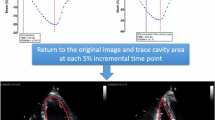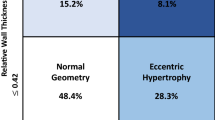Abstract
Establishment of upper normal limits of physiological hypertrophy in response to physical training is important in the differentiation of physiological and pathological left ventricular hypertrophy. The genetic differences that exist in the adaptive response of the heart to physical training and the causes of sudden cardiac death in young athletes indicate the need for population-specific normal values. Between September 1994 and December 2001, 442 (306 male, 136 female) elite British athletes from 13 sports were profiled. Standard two-dimensional guided M-mode and Doppler echocardiography were employed to evaluate left ventricular morphology and function. Eleven (2.5%) athletes, competing in a range of sports including judo, skiing, cycling, triathlon, rugby and tennis, presented with a wall thickness >13 mm, commensurate with a diagnosis of hypertrophic cardiomyopathy. Eighteen (5.8%) male athletes presented with a left ventricular internal diameter during diastole (LVIDd) >60 mm, with an upper limit of 65 mm. Of the 136 female athletes, none where found to have a maximum wall thickness >11 mm. Left ventricular internal diameter was <60 mm in all female athletes. Systolic and diastolic function were within normal limits for all athletes. Upper normal limits for left ventricular wall thickness and LVIDd are 14 mm and 65 mm for elite male British athletes, and 11 mm and 60 mm for elite female British athletes. Values in excess of these should be viewed with caution and should prompt further investigation to identify the underlying mechanism.


Similar content being viewed by others
References
Batterham AM, George KP, Whyte G, Sharma S, McKenna W (1999) Scaling cardiac structural data by body dimensions: a review of theory, practice and problems. Int J Sports Med 20: 495–502
Corrado D, Thiene G, Nava A, Rossi L, Pennelli N (1990) Sudden death in young competitive athletes: clinicopathologic correlations in 22 cases. Am J Med 89: 588–596
Devereux R, Reichek N (1977) Echocardiographic determination of left ventricular mass in men: anatomic validation of the meathod. Circulation 55: 613–618
Dubois D, Dubois E (1916) Clinical calorimetry. A formula to estimate the approximate surface area if height and weight be known. Arch Intern Med 17: 863–871
George KP, Wolfe LA, Burggraf GW (1991) The ‘athletic heart syndrome’. Sports Med 11: 300–330
George K, Gates P, Whyte G, Fenoglio R, Lea R (1999) Echocardiographic examination of cardiac structure in elite cross-trained male and female alpine skiers. Br J Sports Med 33: 93–99
George K, Sharma S, Batterham A, Whyte G, McKenna WJ (2001) Allometric analysis of the assocition between cardiac dimensions and body size variables in 464 junior athletes. Clin Sci 100: 47–54
Henschen S (1899) Skidlauf und Skidwettlauf. Eine medizinische Sportstudie. Mitteilungen aus der medizinischen Klinik zu Upsala. Fischer, Jena
Lapido GOA, Dunn FG, Pringle TH, Bastian B, Lawrie TDV (1980) Serial measurements of left ventricular dimensions by echocardiography. Assessment of week-to-week, inter- and intraobserver variability in normal subjects and patients with valvular heart disease. Br Heart J 44: 284–288
Leonardis V de, Cinelli P (1986) Evidence of no interobserver variability in M-mode echocardiography. Clin Cardiol 9: 324–327
Maron B (1986) Structural features of the athletes heart as defined by echocardiography. J Am Coll Cardiol 7: 190–203
Montgomery H, Clarkson P, Dollery C, Prasad K, Losi M, Hemingway H, Statters H, Jubb M, Girvain M, Varnava A, World M, Deanfield J, Talmud P, McEwan J, McKenna WJ, Humphries S (1997) Association of angiotensin-conversting enzyme gene I/D polymorphism with change in left ventricular mass in response to physical training. Circulation 96: 741–747
Morganroth J, Maron B, Henry W, Epstein S (1975) Comparative left ventricular dimensions in trained athletes. Ann Intern Med 82: 521–524
Myerson S, Hemingway H, Budget R, Martin J, Humphries S, Montgomery H (1999) Human angiotensin I-conversting enzyme gene and endurance performace. J Appl Physiol 87: 1313–1316
Pelliccia A, Maron BJ, Spataro A, Proschan M, Spirito P (1991) The upper limits of physiologic cardiac hypertrophy in highly trained athletes. N Engl J Med 324: 295–301
Pelliccia A, Maron BJ, Culasso F, Spataro A, Caselli G (1996) Athlete’s heart in women. Echocardiographic characterization of highly trained elite female athletes. JAMA 276: 211–215
Pluim B, Zwinderman A, van der Laarse A, van der Wall E (1999) The athlete’s heart: A meta-analysis of cardiac structure and function. Circulation 100: 336–344
Sahn DJ, DeMaria A, Kisslo J, Weyman A (1978) Recommendations regarding quantitation in M-mode echocardiography: results of a survey of echocardiographic measurements. Circulation 58: 1072–1083
Sharma S, Whyte G, McKenna WJ (1997) Sudden death from cardiovascular disease in young athletes: fact or fiction. Br J Sports Med 31: 269–276
Urhausen A, Kindermann W(1992) Echocardiographic findings in strength- and endurance-trained athletes. Sports Medicine 13: 270–284
Whyte G, George K, Sharma S, Martin L, Draper N, McKenna W (2000) Left ventricular structure and function in elite Judo players. J Clin Exp Phys 2: 204–208
Acknowledgement
The authors wish to thank Cardiac Risk in the Young (CRY) for their support of this work.
Author information
Authors and Affiliations
Corresponding author
Rights and permissions
About this article
Cite this article
Whyte, G.P., George, K., Sharma, S. et al. The upper limit of physiological cardiac hypertrophy in elite male and female athletes: the British experience. Eur J Appl Physiol 92, 592–597 (2004). https://doi.org/10.1007/s00421-004-1052-2
Accepted:
Published:
Issue Date:
DOI: https://doi.org/10.1007/s00421-004-1052-2




